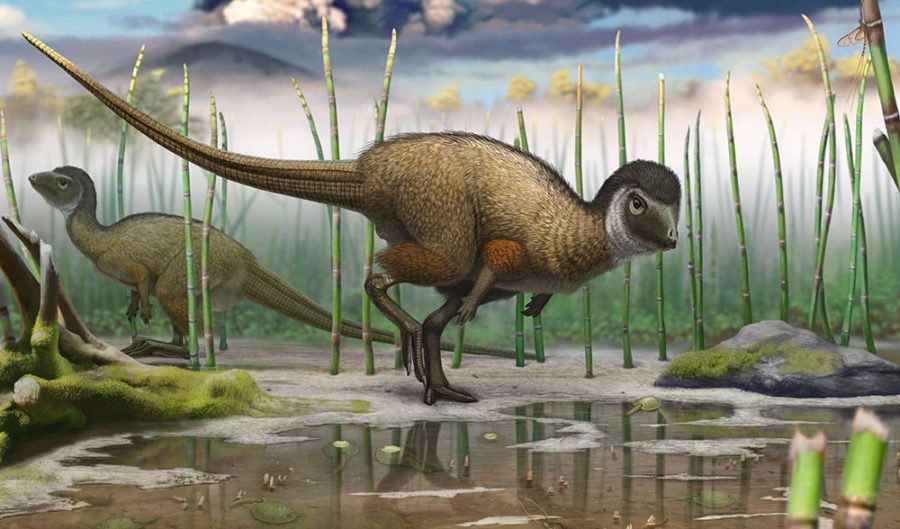Were all dinosaurs feathered?

John Pickrell
John Pickrell

NEW DINOSAUR DISCOVERIES (such as four-winged Changyuraptor) seem to come nearly every week these days, but few are this exciting.
Fossils of a new species from Siberia may be some of the best evidence yet that feathers were not restricted to the carnivorous theropods but were in fact a trait shared by all groups of dinosaurs.
Detailed in the journal Science today, Kulindadromeus zabaikalicus (Kal-in-DA-drome-ay-us), was a small, 1.5m-long ornithischian dinosaur from the Early Jurassic of eastern Russia. Scientists led by Pascal Godefroit at the Royal Belgian Institute of Natural Sciences in Brussels described the species from six skulls and hundreds of disarticulated skeletons they discovered.
In amongst the bones they found impression of a variety of different scale types as well as several different filaments, which they interpret to be feather-like structures similar to those seen on carnivorous dinosaur Sinosauropteryx. This species was the first dinosaur found with feathery filaments back in 1996.
Siberian dinosaur with feathers
But why is this significant you ask? The dinosaur family tree is split into two major branches: the saurischian dinosaurs (which include all the carnivores theropods and the long necked sauropods) and the ornithischians (which includes all the herbivorous duck billed and armoured dinosaurs).
So far around 40 species of feathered dinosaurs have been found, but the majority of these are carnivorous theropods (see a full list of feathered dinosaurs here).
Only two dinosaurs in the ornithischian branch (Tianyulong and Psittacosaurus) had previously been found with bristle- or filament-like structures which may or may not have been related to feathers. Based on this, some experts recently claimed that feathers were not widespread across all dinosaurs and were mostly an innovation of the theropods.
This new discovery may turn that idea on its head. Kulindradromeus has filaments that appear much more feather-like, and it’s also an early member of the entire ornithischian group. When you have an early member of a group that has feathers, it means it’s likely that its descendants would have had feathers too.
One of the recent arguments against ornithischians having feathers was that there are many fossils with skin impression for duck-billed and armoured dinosaurs which showed they had scales. However, the fossils of the new species show that it had feathery filaments and scales, which means that the presence of scales doesn’t necessarily rule out feathers.
Watch Pascal Godefroit at the Royal Belgian Institute of Natural Sciences talk about the unusual level of fossil preservation at Kulinda in Siberia:
Did Triceratops have feathers?
So now we have three ornithischian dinosaurs, in different parts of the family tree, all with feather-like structures. There have even been tantalising rumours of a Triceratops skin impression held at the Houston Museum of Natural Sciences in Texas, which has bristle impressions, but nothing has yet been published on this.
It’s entirely plausible that feathers are a trait that are not only shared by most dinosaurs but which predated the group entirely and evolved in an ancestor to both dinosaurs and pterosaurs (flying dinosaur-era reptiles, which are a related group). Chinese dinosaur expert Xu Xing, who discovered many of the feathered species, says there is evidence for fluffy or furry covering in many pterosaur fossils and this may well have been a kind of primitive feather too.
Another reason why the new fossil is exciting, is that it adds to the number of feathered dinosaurs found outside China. Up until now, most of the 40 or so feathered species come from China, but a smattering have been found elsewhere, such as in Canada, the US, Madagascar and Germany.
Though no Australian dinosaurs have yet been found with feathers, a series of 115-million-year-old feathers have been found near Koonwarra in Victoria and they may have once belonged to dinosaurs.
See the Sep/Oct print edition of Australia Geographic to learn more about an expedition that will attempt to find feathered dinosaurs in Koonwarra in 2017. There’s also a fantastic poster of Australian dinosaurs, which is free for subscribers.
John Pickrell is the author of Flying Dinosaurs: How fearsome reptiles became birds, published by NewSouth Books in June 2014. Follow him on Twitter @john_pickrell.

